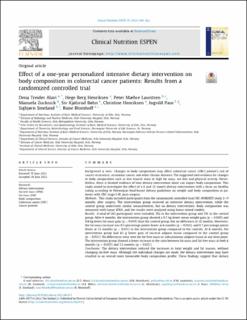| dc.description.abstract | Background and aims
Changes in body composition may affect colorectal cancer (CRC) patient's risk of cancer recurrence, secondary cancer, and other chronic diseases. The suggested interventions for changes in body composition such as low muscle mass or high fat mass, are diet and physical activity. Nevertheless, there is limited evidence of how dietary intervention alone can impact body composition. This study aimed to investigate the effect of a 6 and 12 month dietary intervention with a focus on healthy eating according to Norwegian food-based dietary guidelines on weight and body composition in patients with CRC stage I-III, post-surgery.
Methods
This study included participants from the randomized controlled trial CRC-NORDIET study 2–9 months after surgery. The intervention group received an intensive dietary intervention, while the control group underwent similar measurements, but no dietary intervention. Body composition was measured with Lunar iDXA, and the results were analyzed using linear mixed models.
Results
A total of 383 participants were included, 192 in the intervention group and 191 in the control group. After 6 months, the intervention group showed a 0.7 kg lower mean weight gain (p = 0.020) and 0.6 kg lower fat mass gain (p = 0.019) than the control group, but no difference at 12 months. Moreover, the fat mass increase was 0.5 percentage points lower at 6 months (p = 0.012), and 0.7 percentage points lower at 12 months (p = 0.011) in the intervention group compared to the controls. At 6 months, the intervention group had 63 g lower gain of visceral adipose tissue compared to the control group (p = 0.031). No differences were seen for fat-free mass or subcutaneous adipose tissue at any time point. The intervention group showed a lower increase in the ratio between fat mass and fat-free mass at both 6 months (p = 0.025) and 12 months (p = 0.021).
Conclusion
The dietary intervention reduced the increases in total weight and fat masses, without changing fat-free mass. Although the individual changes are small, the dietary intervention may have resulted in an overall more favourable body composition profile. These findings suggest that dietary intervention may be part of a treatment strategy for prevention of weight and fat mass gain in CRC survivors. | en_US |

